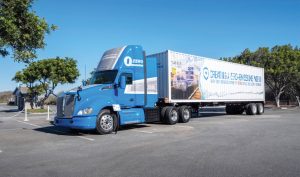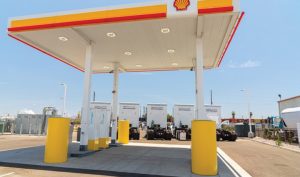
Per their 2017 Clean Air Action Plan (CAAP) pact, the Los Angeles and Long Beach seaports continue their push to establish a zero-emissions platform by 2035. The plan aims to eliminate all carbon-emitting drayage trucks and transition the current fleet servicing the ports to zero-emissions operations by the deadline.
While advancements in technology, namely electric and hydrogen fuel-cell technology, are keeping pace in making a zero-emissions future possible, the high cost of transitioning to zero-emission trucks and a lack of charging and fueling infrastructure present genuine concern for the ports and drayage service providers alike.
Many truck manufacturers are already in the testing phase of zero-emissions technology at the ports, including Nikola’s Tre battery-electrics, Volvo’s VNR battery-electrics, Daimler Trucks’ e-Cascadia, and Kenworth’s hydrogen fuel trucks, powered by Toyota’s fuel-cell technology.
Toyota Motor North America intends to take its integrated dual fuel-cell modules from prototypes to full-scale production in 2023. The modules, destined for use in hydrogen-powered heavy-duty commercial trucks, offer a 300-plus mile range and are designed to work with a variety of existing platforms across several truck manufacturers.
“The inherent modularity of fuel-cell electric systems lends itself well to ‘plug and play’ installation across current and future mobility and power generation applications,” said Ash Corson, Senior Manager, Toyota Motor North America Research and Development. “Heavy-duty fuel-cell electric truck technology is being proven in revenue service as both operationally and economically viable in terms of customer adoption, total cost of ownership and available market incentives.”

Economic Viability
Despite Corson’s claim that Toyota’s fuel-cell technology is economically viable in terms of cost of ownership, the exact cost for the technology is currently unknown. However, Matt Schrap, CEO of the Harbor Trucking Association, said everything he’s read and heard about the technology points to quite a price tag.
“Certainly, the hydrogen trucks are more appealing because of the shorter fuel time and longer range, but the cost is astronomical,” he said. “Everything I’ve heard and read says these hydrogen fuel-cell trucks cost upward to one million bucks.”
The high cost of transitioning to a zero-emissions platform is evident through the ports’ announcement that they’ll begin collecting their Clean Truck Fund (CTF) rates in April. Officials expect to generate $90 million in the first year ($45 million per port).
“The Clean Truck Fund rate is a key component of the port’s efforts to transition to a zero-emission truck fleet by 2035, as established by the Clean Air Action Plan,” Port of Long Beach Executive Director Mario Cordero said.
“The rate for non-exempt trucks of $10 per twenty-foot equivalent unit – a standard measure for one 20-foot-long cargo container – was set in March 2020 by the ports to encourage the trucking industry to invest in cleaner vehicles and reach zero-emissions,” Cordero explained. “Zero-emission trucks are exempt from the rate, and Long Beach has approved an expiring exemption for the cleanest natural gas-powered trucks as a transitional step to a future when zero-emission cargo trucks are widely available.”
Currently, it’s unclear what the incentives to help operators afford zero-emission vehicles in the future will be. And even if trucking companies could afford the hefty cost of purchase, the technology that will likely fuel a zero-emissions platform has not yet reached the market—which is a roadblock the ports are currently attempting to navigate.
Challenges
“The greatest challenges are the availability of zero-emission trucks, the cost of these early-generation models and the time and expense to install infrastructure to support these vehicles,” Cordero said. “However, we are investing and working with our partners to do everything we can to ensure the technology is advancing and can become commercialized, which will bring down the costs and improve availability over time.”
While the affordability and availability of zero-emission trucks remain a concern for drayage service providers and the ports alike, the time and expense to install the necessary infrastructure to support green drayage operations are of more significant concern.
“Honestly, the biggest hurdle is infrastructure,” Schrap said. “It is the biggest hurdle we need to overcome moving forward. A truck is almost the easy part. It’s where the heck are we going to charge these things in a timely fashion? You can throw all the money you want into truck incentives, but if we don’t have ways to fuel or charge the trucks in a timely fashion, this is doomed to fail.”
Thus far, Los Angeles and Long Beach have concentrated on large-scale demonstrations of how zero-emissions equipment and infrastructure will work in the future. The demonstrations can help assess the technological and logistical feasibility of using zero-emission trucks in a real-world setting.
“Much of our efforts now are focused on pilot demonstrations of vehicles, including trucks,” Cordero said. “We have worked with our partners to secure about $80 million in mostly state and some federal grants to demonstrate zero-emissions equipment in terminal operations. The grants are helping to pay for $160 million worth of projects across the port. The zero-emissions equipment is being deployed now at all of our container terminals.”
“Lessons learned under this program,” he continued, “will be used to improve next-generation battery-electric trucks, making the results of our project incredibly valuable to our transition to zero-emission drayage operations by 2035.”
Fueling Infrastructure
While technically still in a demonstration phase, the Port of Los Angeles’ efforts have cultivated actual infrastructure development in the form of two new high-capacity hydrogen fueling stations in Wilmington, along with Ontario, Calif.— a common Inland Empire drayage destination.
The fueling stations result from a partnership between the Port of L.A., Toyota Motor North America, Kenworth Truck Co. and Shell Oil Products U.S. under the $82.5 million Shore-to-Store (S2S) 12-month demonstration project.
Also, the State of California has made heavy-duty hydrogen infrastructure development a core focus of its current budget, investment and planning efforts. Officials hopes that attention accelerates adoption of zero-emissions heavy-duty hydrogen fuel-cell electric trucks at scale, according to Corson at Toyota Motor North America.
Both public and private stakeholders in the ports and greater Los Angeles basin are coordinating to develop heavy-duty hydrogen fueling infrastructure beyond the five such stations already in operation.
While adding two high-capacity hydrogen fueling stations is a step in the right direction in building necessary infrastructure, it’s merely a drop in the bucket for what it will take to support every truck coming in and out of the ports. Zero-emission trucking will likely consist of battery-electric and hydrogen-fueled vehicles—each requiring different and unique charging and fueling needs.
“The infrastructure is the red hearing of this entire situation. There’s just not enough public subsidy out there,” Schrap commented. “We’re talking 14,000 trucks that pull into the harbor every day. That’s a lot of charging and fueling stations. And as it is now, it takes two to three hours to charge a battery-electric truck. Hence, there’s a mountain of logistic and financial hurdles to overcome to make this a reality.”
‘How Do We Get There?’
The drayage trucking industry’s concerns stem from the fact that they will soon incur Clean Truck Fund fees based on the assumptions that clean technology will become more affordable in the near future, or that future incentives made possible through the fund—which are currently unclear—will make zero-emission truck purchases a viable option.
Furthermore, the operational model needed to support zero-emission trucks is nowhere near where it needs to be to enable such a significant transition.
“Companies are being asked to purchase trucks that cost at least four times as much, yet will be compensated exactly the same and will be completing the exact same work as before,” Schrap said. “No trucking company, big or small, can absorb the cost of a single truck that’s upwards of a million dollars when productivity hasn’t changed.”
“We’re still only able to complete the same amount of turns in a given day,” he added. “Obviously, this is raising concerns for us.”
“No one in my industry is saying we don’t want electric or zero-emission trucks,” Schrap continued. “No one is challenging this future that we’re all driving towards at breakneck speed. The technology is great. The cause is noble and necessary. It’s more a question of how do we get there?”
“We in the trucking industry, need clarity and assurances that this transition will be viable and sustainable, economically speaking,” he said. “We need real talk.”

